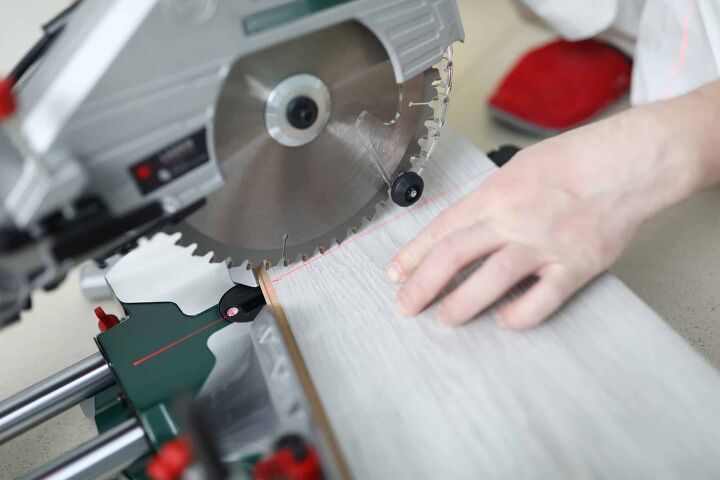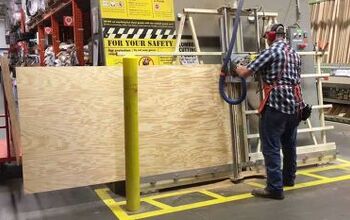21 Different Types of Wood Cutting Tools (with Photos)

With wood being the most popular material used for DIY projects, knowing how to cut it is a skill that nearly all DIY enthusiasts desire to have. As you might expect, there are many tools on the market designed specifically for cutting wood. So long as you select the right type of wood cutting tool for your project, the process should be relatively straightforward.
The most common category of wood cutting tools are saws, which have been used to cut wood for thousands of years. Today’s comprehensive wood cutting tool collection consists of a variety of saws, from hacksaws to coping saws, to a wide array of specialized table saws, and even a number of specialized cutting tools, like tree loppers and lathes.
With that said, we’ve gathered a full list of various types of wood cutting tools to expand your understanding of the subject. Continue reading for our guide on 21 different types of wood cutting tools.
Hand Saws
Over the years, hand saws have evolved to satisfy many cutting styles and niches. While some saws are general-purpose tools, like the traditional hand saw, others were designed for very particular applications, such as the keyhole saw. Let’s take a look at the various wood cutting tools that fall under the category of “hand saws.”
1. Backsaw
A backsaw is a type of hand saw that is characteristic of being relatively short, with a narrow blade that is reinforced along the edge opposite the cutting edge – lending to the name. The stiffening rib on the upper edge of the saw allows for better control and more precise cuts than other alternatives.
Back saws are most often used in woodworking for very detailed work, like cutting miters, dovetails, or tenons in joinery or cabinetry. Because of the reinforcement on the upper edge, backsaws tend to be limited in the depth you can cut. They also have teeth that are spaced relatively close together, generally with little to no set.
Some examples of back saws include the dovetail saw, the tenon saw, miter saw, and the sash saw (found in the UK).
2. Bow Saw
Another type of hand saw, the bow saw is often found used outdoors than inside. It has a relatively long blade and features many teeth in a cross-cut pattern. This allows the bow saw to remove more materials easily by simply pushing and pulling. Bow saws are commonly used for trimming trees, cutting logs, and pruning, but may also be implemented for any other type of rough-cut.
While you can certainly use a bow saw for pruning, the pruning saw is often preferred for this purpose as it’s much easier to grip in one hand while standing on a ladder. If you perform a lot of work outdoors, you’ll definitely want to have a bow saw in your collection. It is the ideal choice to perform many types of outdoor woodcutting.
3. Coping Saw
A coping saw is easily recognizable by its unique design. The thin, narrow blade is ideal for scrolling, trim work, and any other cuts that require precisions and intricacy. They can also be used for making curved cuts and cutting elaborate shapes out of wood. Using a coping saw may require some skill and experience, but once you get the hang of it, you’ll be glad you have this tool in your collection.
The think blade of a coping saw makes it very easy to change directions while cutting, achieving clean cuts every time. Aside from wood, these types of saws can be used to cut a wide array of materials and are often found in the toolkits of everyone from plumbers and carpenters to furniture and toymakers.
4. Hacksaw
Ideal for cutting tubing and piping, the hacksaw is one of the most common types of saws. It can also be quite handy when you need to cut wood, especially logs. Hacksaw are very affordable and widely available tool, found at virtually any hardware store. They are simple to operate, lightweight, and incredibly reliable, which makes them an essential woodcutting tool to own.
Hacksaws are versatile and multipurpose tools, in that you can remove the blade and insert a different one that is specifically designed for cutting the material you’re working with. Depending on the blade you have, the tooth count will vary – from 18 to 32 per inch. If you’re looking to use a hacksaw for cutting wood, make sure that you have the correct blade for this material.
5. Crosscut Saw
When you need to cut through rough wood, you’re going to want to have a crosscut saw in your collection. This type of saw is characterized by a have a thick, large blade and relatively large, beveled teeth. The design of the teeth makes it easy to cut through large tree limbs and even full tree trunks. If you cut through rough pieces of wood regularly, you’ll definitely want to own a quality crosscut saw. It also makes an excellent saw for at the job site or while camping.
Woodcutting tools like this one are invaluable when you need to make efficient cuts, as it’s always best to have a saw that is both durable and reliable. A high-quality crosscut saw will also last you for years to come, serving many outdoor woodcutting purposes. This specific saw is often referred to as a “one-man crosscut saw” as there is also a “two-man” version.
6. Two-Man Crosscut Saw
The other type of crosscut saw on the market is known as a two-man crosscut saw. As the name suggests, this type of woodcutting tool is operated by two people. The traditional two-man crosscut saw, or felling saw, consists of a handle on either side for cutting across (perpendicular) the grain of wood.
Although less common than the conventional one-man crosscut saw, the two-man variety allows for a quick and easy way to cut down trees. In fact, many prefer cutting down trees using this, more archaic, method than using power tools. By distributing the task between two individuals, cutting is much less taxing than if you were to use a different tool.
If you intend to fell some trees, you may want to add a two-man crosscut saw to your collection. Though they aren’t nearly as common as other woodcutting tools on this list, you’ll still be able to find them at most hardware stores.
7. Japanese Saw
Designed with a single handle and an extended thin, durable cutting blade, the Japanese saw is far more precise than a backsaw. The main advantage of this type of saw is that it can reach places where other woodcutting tools cannot. Ideal for woodcutting, the Japanese saw is available in three different types: kataba, ryoba, and dozuki. They can be used for cutting both hard or softwoods with equal precision and are especially useful for detail work.
Japanese saws are incredibly lightweight and are operated by simply pulling on the handle. They require a lot less strength than something like a hack saw or many other types of hand saws. If you are a woodworking enthusiast, a Japanese saw is a very desirable woodcutting tool to have in your collection – especially if you are lacking upper body strength.
8. Keyhole Saw
Keyhole saws are designed for cutting both metal and wood. Also called a jab saw, pad saw, drywall saw, or alligator saw, this type of woodcutting tool is characterized by being long, narrow, and relatively small. It is most often used for cutting awkward features in a variety of building materials. Generally speaking, there are two types of keyhole saws: the retractable blade type and the fixed blade type.
The retractable blade variety is typically found with either a cast-iron or wooden handle. With the ability to retract the blade to an ideal length, you can prevent unwanted flex while cutting. The cheaper, fixed-blade type of keyhole saw is more often used in modern construction for rough cutting circles or patterns.
9. Rip Cut Saw
A rip cut saw, or ripping saw, is often the tool that people think of when they imagine a hand saw, and it’s often simply referred to as a hand saw. They are the most common type of hand saw available. It is a great wood cutting tool for cutting through boards with efficiency and is very easy to bring with you to various job sites.
One of the downsides to this type of tool is that it requires quite a bit of arm strength in order to operate properly. There is also a bit of technique involved in using a rip cut saw. However, once you understand how to properly put your weight into the sawing motion, a rip cut saw is relatively simple to use. Rip cut saws are also very cost-effective and serve many purposes, making them the ideal woodcutting tool to own.
10. Pruning Saw
Pruning saws are an essential tool for tree surgeons for making very particular cuts to tree limbs. It’s likely that you might also see your landscaper carrying one of these tools. They most often come with a curved blade that is between 13 to 15 inches in length that protrudes from a single “pistol grip” handle style. The blade is relatively wide with coarse teeth, making it able to cut in both directions for quick, efficient material removal.
Aside from being used by landscapers, lawn services, and tree surgeons, pruning saws are also very common in homeowner’s toolkits. If you’re looking to cut tree limbs efficiently using a manual tool, a pruning saw is highly recommended. In fact, many prefer pruning saws over chainsaws and feel much safer operating them.
11. Manual Pole Saw
When you have a thick vine or branch that needs to be cut down and you can’t reach it from the ground with your pruning saw, a manual pole saw is a great choice. Put simply, a pole saw is a saw that’s attached to the end of a pole. It can be manual or powered for tree trimming.
Though more efficient for pruning than a pruning saw, a manual pole saw can be less efficient for brush clearing and trimming. When using a manual pole saw, you need to plan carefully for each cut. This includes where exactly to cut and how and where the branch will fall. You must clear anything at risk out of the fall zone.
As far as cutting goes, it’s recommended to trim closer to the tip of the branch and work your way back towards the cutting point. With a manual pole saw, you want to saw slowly from the top down, using long, deliberate strokes.
Power Saws
Instead of switching between various handheld woodcutting tools, power saws have evolved to fulfill niches of their own. Power saws tend to fall into three main categories: Circular Blade, Reciprocating Blade, and Continuous Band. Let’s take a look at some of the many power saws that can be used for cutting wood:
12. Hole Saw
A hole saw, also referred to as a hole cutter, is a type of saw blade that is used alongside a power drill. It is angular (ring) in shape, which results in a hole in the workpiece without having to cut up the material. Hole saws are used for cutting perfectly round holes in wood, concrete, metal, plastic, stainless steel, and other materials.
You essentially graduate up to a hole saw when you don’t have a spade bit that is large enough. Depending on the material that you need to cut, the material of the blade will vary. Bi-metal hole saws are generally the most versatile. However, diamond-coated or carbide teeth are usually required for cutting holes into much harder materials than wood. Since a hole saw creates a hole without the need to cut up the core, it’s often preferred to spade drills or twist drills for making big holes.
13. Band Saw
If you do a lot of woodworking projects, a band saw is one tool that you’ll definitely want to have in your toolkit. This type of saw comes in both a portable and stationary version. The stationary variety is tall and floor-standing. It uses large pulleys above and below the cutting surface to operate a continuous band with fine teeth to cut through a variety of materials.
Band saws are ideal for making precise cuts and smooth curves in wood materials. However, they can also be great tools to cut a number of other materials. One of the downsides to this woodcutting tool is that it can have a heft price tag. Therefore, you’ll definitely want to think carefully about how badly you need a band saw before you fork over a large sum of money.
14. Chainsaw
If your goal is to chop down trees as quickly as possible, a chainsaw is the ideal tool. Chainsaws are very important tools for those who need to chop through thick trees, as a quality chainsaw can cut through wood very effectively and are relatively easy to operate. They are commonly used for cutting through thick logs to make transport much easier.
As the name suggests, chainsaws utilize a linked chain with a number of specially designed ripping teeth. Although chainsaws have a very unique design, they technically fall under the category of band saws. While they are most commonly used for tree work than any other purpose, depending on your region, a chainsaw may be an essential tool for homeowners.
When choosing a chainsaw, it’s important that you select one that is lightweight enough for you to use comfortably. Therefore, make sure you take some time deciding on the right chainsaw for you.
15. Chop Saw
The chop saw is one of the largest portable versions of the traditional circular saw. Chop saws come in both masonry and metal cutting versions, making it easy to cut through masonry, metal, composite materials, wood, and even lumber with embedded nails. Different blades can be purchased for chop saws, depending on the material you need to cut.
When used for cutting wood, chop saws are meant for precisely and accurately both angled and square cuts. This type of woodworking tool operates by spinning a circular steel saw blade at a rapid speed. The saw is laid on a table and the blade cuts through wood by simply pushing down on the handle.
Chop saws come in a range of different styles with varying features and you can choose the right one for you based on your cutting needs and budget.
16. Miter Saw
The miter saw is very similar to chop saws, and they are often confused for being the same tool. However, the main difference between a miter saw and a chop saw is that chop saws cut 90-degree angles and are much larger (the blade is a minimum of 14 inches). Chop saws also tend to have more power than miter saws.
On the other hand, miter saws cut beveled, angled, and compound cuts. Since they can rotate and pivot left and right, the miter saw is much more versatile. It is known as one of the few saws that was specifically designed to mimic a hand saw. A miter saw is the ideal tool for use in trim cuts or any other jobs that involve angle cuts and precise measurements.
17. Jigsaw
A jigsaw is a handheld power saw with a short, fine-toothed blade that moves up and down at varying speeds. This is one of very few woodcutting tools that are specifically designed for cutting curves and other non-straight lines. When you need to cut curves into wood, a jigsaw is an excellent tool for this purpose. It is very useful for both cutting curves, but can also cut straight lines in pieces of lumber.
Jigsaws come in both corded or cordless options for convenience. They can be used for cutting a variety of materials including wood, plastic, metal, and laminate. All you’ll need for efficient cutting is to choose the proper blade. For cutting wood, a carbon steel blade is often the best choice. If you want a more accurate, clean cut, opt for a fine-toothed blade, or for cutting wood faster, choose a coarse blade.
18. Table Saw
If you need to make numerous rip cuts or cut a large number of identically-sized pieces of lumber, a table saw is an excellent tool. In fact, a table saw is the type of saw that most professionals use for preparing lumber in many situations. However, these types of tools can also take masonry and metal blades.
The table saw consists of a circular saw blade that is mounted on an arbor and is driven by an electric motor. The blade juts through the top of a table, which provides support for the material, most often wood, being cut. In most modern table saw designs, the depth of the cut varies by moving the blade up and down. The higher the blade comes out of the table, the deeper the cut in the material.
19. Routers
Routers are very strong and powerful power tools that many people use to cut wood on a daily basis. These tools are very commonly used for constructing fine cabinets, as they can do very intricate work. While this tool is certainly used for woodworking, whether or not it can be considered a woodcutting tool is often up for debate.
A router can be used to cut wood, but it performs a more specialized and unique cut. It is meant for routing out or hollowing out an area of wood that is relatively hard. Routers can also be used to cut fancy edges, nearly flawless rabbets and dadoes, and even create very intricate wood patterns. Their main purpose is in woodworking and carpentry, especially in cabinetry.
Other Wood Cutting Tools
20. Tree Loppers
Tree loppers are another type of woodcutting tool that is designed for pruning woody trees and shrubs. They are essentially hand pruners with long handles. Although the longer handles will give you some additional reach for pruning higher branches, this isn’t their primary advantage. The handles on loppers give you leverage, that way you can prune larger branches – up to two inches in diameter, depending on the specific model of tree lopper.
Since tree loppers have very long handles, they can be quite awkward to hold and use. Therefore, you’ll want to test out a couple to ensure that you choose a lopper that fits comfortably in your hands. Depending on the thickness of the branches you are pruning, tree loppers may be the best tool for the job. However, particularly thick tree limbs will require something more powerful, like a chainsaw.
21. Ax
An ax is a very traditional tool that is often associated with old-fashioned lumberjacks for cutting down trees. They have been used for millennia for shaping, splitting, and cutting wood, to create weapons, harvest timber, or as some sort of ceremonial symbol. Nowadays, many still use small axes for cutting down trees or slitting logs to create firewood. While useful, axes aren’t as easy to operate as something like a chainsaw.
Though the ax comes in many forms with varying specialized uses, they most often consist of an ax head with a handle, or “helve.” It serves as an example of a simple machine, as it is a type of wedge, or dual inclined plane. This helps to reduce the effort required by the user to split wood into two pieces by concentrating the pressure on the blade.
If you own a fireplace or live in an area where you’ll frequently need firewood on hand, you’ll absolutely want to have an ax among your collection of woodcutting tools.
Related Guides

Jessica considers herself a home improvement and design enthusiast. She grew up surrounded by constant home improvement projects and owes most of what she knows to helping her dad renovate her childhood home. Being a Los Angeles resident, Jessica spends a lot of her time looking for her next DIY project and sharing her love for home design.
More by Jessica Stone
































![10 Best Electric Lawn Mowers - [2022 Reviews & Top Rated Models]](https://cdn-fastly.upgradedhome.com/media/2023/07/31/9070486/10-best-electric-lawn-mowers-2022-reviews-top-rated-models.jpg?size=350x220)
![The 10 Best Table Saws - [2022 Reviews & Buyer's Guide]](https://cdn-fastly.upgradedhome.com/media/2023/07/31/9070645/the-10-best-table-saws-2022-reviews-buyer-s-guide.jpg?size=350x220)














